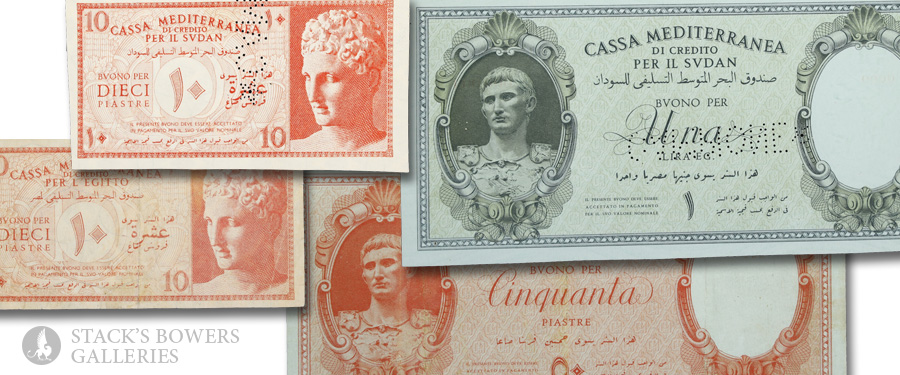
We are putting the finishing touches on the Spring 2025 Maastricht Showcase Auction, and during that process, a quartet of notes came across my desk that made me raise my eyebrows. While at first glance they look to be fairly common notes issued under Italian occupation of Greece during the Second World War, upon closer inspection, they were printed for Sudan and Egypt. The notes, with the same designs as those used in Greece, were never issued as the Italian presence in both countries was brief, and the notes never circulated. The number of surviving examples is extremely small, and we are excited to offer two (what appear to be) issued notes from Egypt and two specimen notes from Sudan.
During World War II, Italy, under Benito Mussolini, launched military operations against Sudan and Egypt as part of a broader strategy to expand its empire in North Africa. The invasion of Egypt began on September 13, 1940, when the Italian 10th Army, commanded by General Rodolfo Graziani, advanced from Libya into British-controlled Egypt. The objective was to capture the vital Suez Canal and weaken British control in the region. However, the Italian advance was slow and cautious, reaching only as far as Sidi Barrani, about 60 miles inside Egypt, before halting to establish defensive positions on September 16, 1940. This hesitation proved costly, as it allowed the British to regroup and launch Operation Compass in December 1940, a major counteroffensive that resulted in a devastating defeat for the Italians. By February 1941, British and Commonwealth forces had pushed the Italians out of Egypt and deep into Libya, capturing thousands of prisoners.
In Sudan, Italy’s military actions were part of a broader campaign in East Africa. In June 1940, shortly after Italy’s declaration of war on Britain and France, Italian forces from Italian East Africa (modern-day Eritrea, Ethiopia, and Somalia) launched attacks on British and Sudanese positions. By July 4, 1940, Italian troops occupied the Sudanese border town of Kassala, along with other small outposts. However, this success was short-lived, as British-led forces, including Sudanese and Ethiopian troops, counterattacked in January 1941. By March 1941, the Italians had been driven out of Sudan, and their East African empire collapsed following the British-led campaign that resulted in the capture of Addis Ababa in April. Italy’s attempts to invade Sudan and Egypt ultimately failed, highlighting weaknesses of military planning and logistical capabilities in the North African and East African campaigns.
Surviving examples of this series are extremely rare. The 1995 Schwan-Boling reference on World War II numismatics contains the little information we know of this series, including the comment that “the best known examples of this set [the Sudan] were part of a specimen group of these and the above Egyptian series. These two sets were split between two prominent collectors, with each keeping half of each issue.” We suspect that Al Kugel was one of the prominent collectors, although we have been unable to confirm this.
The two notes from Egypt that appear to be in ‘issued’ format have been severed and reattached and subsequently repaired. Curiously, the only other issued piece we have seen appear on the market in recent years (a 5 Lire that brought $16,800) was in similar condition, and we suspect that they were either cancelled in this fashion or perhaps smuggled out of the location where they were kept. Regardless, very few notes of either series have appeared on the market, and the quartet of notes offered in our Spring 2025 Maastricht auction represents an extraordinary opportunity for collectors of the region.
While consignments for the Maastricht sale have now closed, we are always accepting quality consignments for future sales. To get the consignment process started, please contact Dennis Hengeveld at [email protected] or call 800-458-4646.





